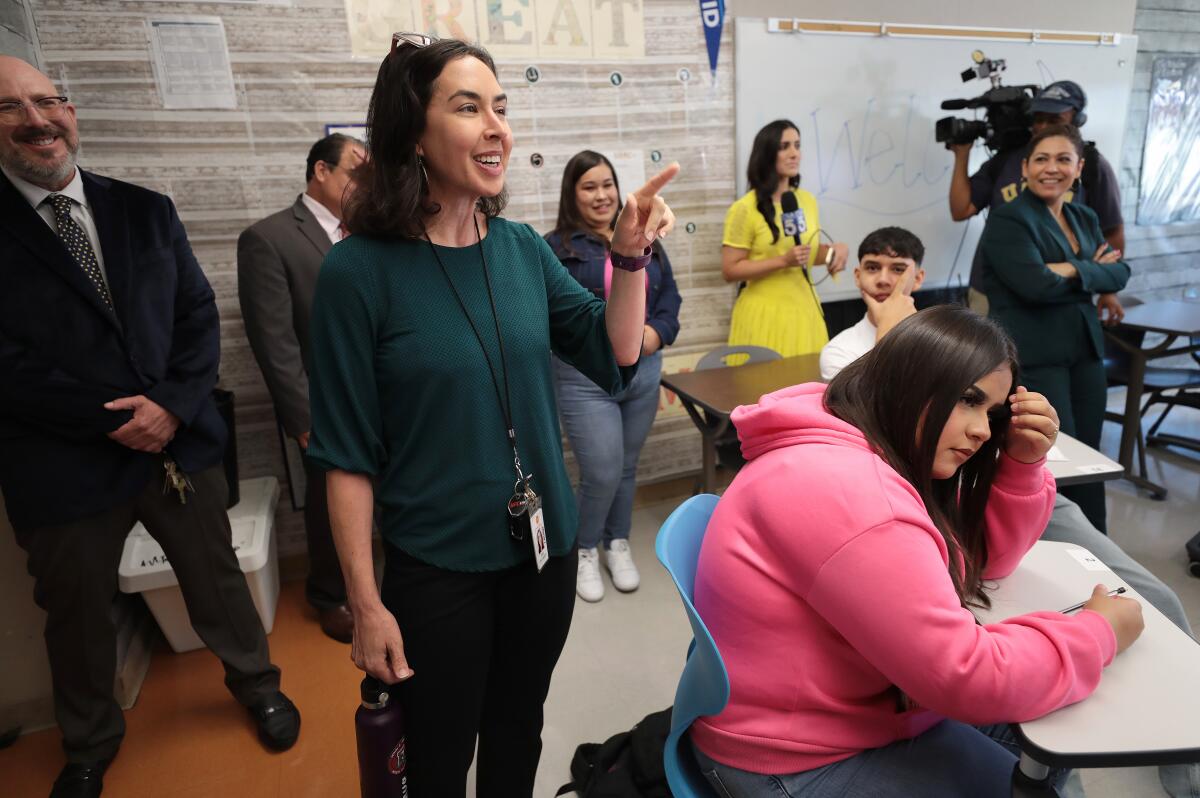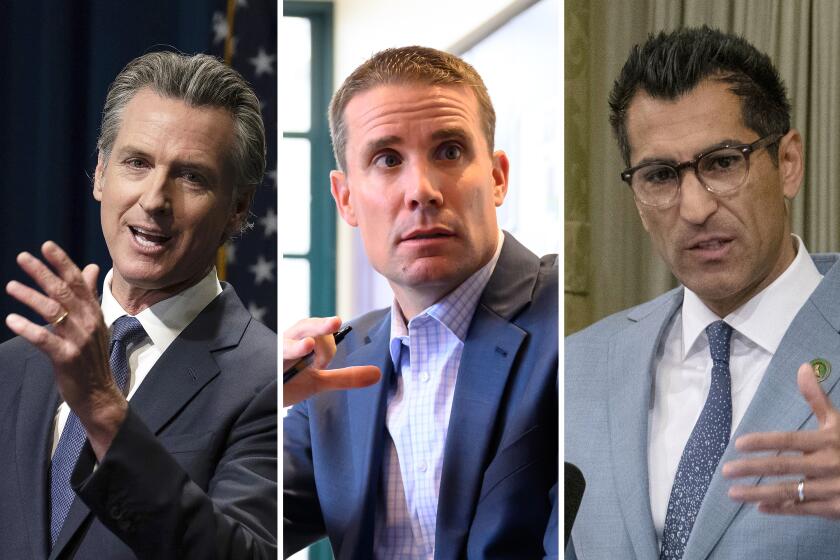Teachers tend to plan pregnancies with summer due dates. Could a LAUSD policy change that?

- Share via
- California teachers do not have access to the state’s paid family leave benefits.
- A new LAUSD board resolution seeks to address the gap and make the district an “employer of choice” for teachers.
- Past state efforts to provide paid leave for teachers have been vetoed.
In teacher’s lounges across California, the same advice is whispered year after year: Plan your babies around summer vacation.
Unlike private sector employees in California, teachers and other public employees do not have access to the state’s paid family leave or state disability insurance programs. This leaves teachers — 73% of whom are women — under a complex set of benefits that require them to use up all of their sick time. Although their jobs are protected for 12 weeks, many cannot afford to take it. Planning a pregnancy around summer vacation allows teacher parents to tack on the summer months, when school is out of session.
“It seems crazy to time a reproductive choice around your work schedule,” said Maya Suzuki Daniels, an English teacher at San Pedro High School. Daniels got lucky, giving birth to her son in July. But she had to go back to work just two weeks after school began, when her son was about 8 weeks old — she couldn’t afford to take the time off.
But a new resolution passed unanimously by the Los Angeles Unified School District board this week seeks to bolster paid family leave for teachers and other district workers, and improve parental support in an effort to make LAUSD a “district of choice” for employees in the midst of a statewide teacher shortage.
California Head Start programs are in panic as the Trump administration threatens to cut the program, ending child care for 80,000 low-income families.
In addressing paid family leave for teachers, the board is attempting to make progress on an issue that has bedeviled the Legislature. Lawmakers have passed two separate bills that would have provided paid leave after a birth; the first was vetoed in 2017 by Gov. Jerry Brown, and the second was vetoed in 2019 by Gov. Gavin Newsom, citing costs. A third attempt, Assembly Bill 65, introduced by Assembly Majority Leader Cecilia M. Aguiar-Curry (D-Winters), is making its way through the Assembly.
Engage with our community-funded journalism as we delve into child care, transitional kindergarten, health and other issues affecting children from birth through age 5.
An appeal to teacher-parents
The LAUSD resolution was introduced by school board members Tanya Ortiz Franklin, Kelly Gonez and Karla Griego — all of them moms.
“We now have a school board that has five moms on it who have some experience being on school staff while having children,” Gonez said. “We know that parenthood is joyful, but we also know the challenges it comes with in a very tangible way.”
“Parental Package: LAUSD as an Equitable Employer of Choice for Thriving Families” addresses a spectrum of parental needs — including infertility support services, paid time off, lactation spaces and child care — but is only the first step. The resolution requires the district to study the reproductive health and parenting needs of employees and come up with a plan of action by November.
This includes determining the cost of providing 12 weeks of paid family leave and researching the possibility of the state paying instead.
The resolution also calls for the district to take several immediate actions, including improving lactation spaces, identifying liaisons at each site to help employees navigate a confusing set of benefits from the district, and finding providers that offer affordable and backup child care for workers.
The effort also aims to improve staff retention and recruitment at a time when hiring enough teachers can prove challenging — especially in an expensive city where the rising cost of having a family outpaces a teacher’s salary.
A new baby at home can be a big transition for families, especially when sleep and bonding issues arise. This hospital is investing in baby mental health to help them through it.
“These are things that will make it so much easier for our employees to stay with the district and to build their families while they continue to build their careers with the district,” Gonez said. “It’s not only good for them, but it’s also good for the district, because increased retention means consistency in the staff at our school sites, and that reaps benefits for students as well.”
The current state of parental leave for teachers
For two decades, California has provided paid family leave for private sector employees who pay into the state disability insurance and paid family leave programs. Private sector workers can access eight weeks of partially paid leave after the birth of a child or to care for an ailing family member. Those who give birth can also access an additional six to eight weeks of paid leave through the state disability insurance program. These benefits have been bolstered in recent years, including paying a higher percentage of worker salaries.
But public sector employees, including teachers, are exempt from paying into these programs and, therefore, are not eligible to receive the benefits. Unions can opt in through labor negotiations, but this is rare.
This leaves teachers under a complex system after the birth of a child. Their jobs are generally protected for 12 weeks, but they must run through their accrued sick days before getting “differential pay” of at least 50% for the rest of the time, according to the California Teachers Assn.
Newer teachers, or those who have already used up their sick days, may have no accrued sick days to use. After health insurance premiums and other costs are taken out of their paycheck, many are left with little to live on, said Erika Jones, an LAUSD teacher and CTA secretary-treasurer.
Keeping an unvaccinated child as a patient could give pediatricians the chance to educate families on vaccines but may also expose more kids to preventable diseases.
“It’s very common to get pregnant and have no pay,” Jones said. “I have been in lunch rooms where women are in labor, dilated, and trying to work until the very last minute because they don’t have enough days.”
Jasmin McGregor, a social worker at Audubon Middle School who shared her story in a video shown at Tuesday’s board meeting, struggled after she had a baby last May.
“Money was very much a stressor during my pregnancy and postpartum period,” she said. “It became very difficult for me and that is one of the reasons I did not take the full 12 weeks of parent bonding. Because I didn’t have any more money.”
Legislative efforts to provide paid leave for teachers
Research has shown that women who have access to paid leave are more likely to return to their jobs after having a baby. Yet the Legislature’s two previous efforts to extend paid family leave to teachers have failed.
“When it comes to teachers, they’ve been totally abandoned in this regard,” said Liz Morris, co-director of the Center for WorkLife Law at UC College of the Law, San Francisco. “Failing to provide paid leave for teachers is shortsighted, because [it] goes a long way in retaining teachers.”
In 2019, Newsom vetoed a bill that would have provided teachers with six weeks of paid maternity leave. “Providing every California worker with paid family leave is a noble goal and a priority for my administration,” he said in his veto message. “However, this bill will likely result in annual costs of tens of millions of dollars and should be considered as part of the annual budget process and as part of local collective bargaining.”
This legislative session, AB 65 would provide 14 weeks of paid leave to school and community college employees. The bill, which is estimated to cost about $120 million annually, would be paid for through Proposition 98 general funds and has the support of the teachers unions.
But opponents, including the Assn. of California School Administrators and the California School Boards Assn., say the law would be unaffordable for districts because there is no dedicated funding source and would exacerbate staffing shortages.
Instead, parental leave should be bargained through teacher union negotiations, said Dorothy Johnson, legislative advocate for the Assn. of California School Administrators. “To have a blank check for this level of leave — there’s no way to really plan or prepare for it from a staffing or financial standpoint, which in the end hurts students.”
This article is part of The Times’ early childhood education initiative, focusing on the learning and development of California children from birth to age 5. For more information about the initiative and its philanthropic funders, go to latimes.com/earlyed.
More to Read
Sign up for Essential California
The most important California stories and recommendations in your inbox every morning.
You may occasionally receive promotional content from the Los Angeles Times.

















